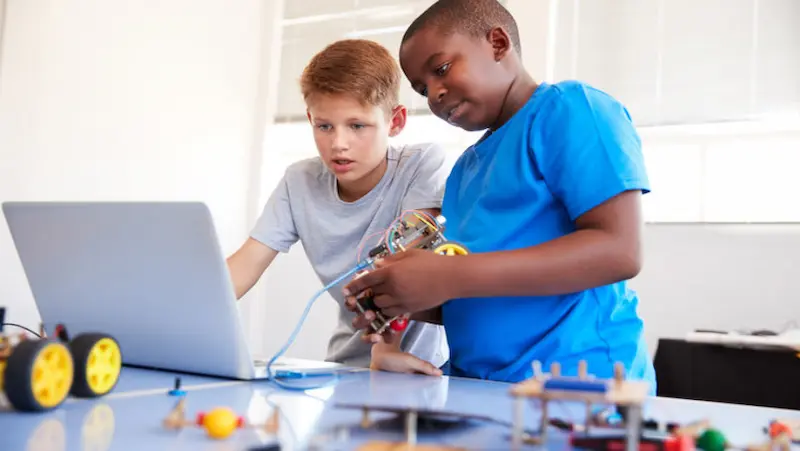In a world where screens have become an integral part of childhood, finding free games for kids that are not only entertaining but also beneficial can be a challenging task. However, the right selection of games can offer a multitude of advantages, contributing to a child’s development in various ways. Let’s delve into the world of free games for kids, exploring their role in child development and presenting the 10 best free games for your young ones.
Table of contents
- The Role of Gaming in Child Development
- 1: Fortnite
- 2: Minecraft
- 3: Roblox
- 4: Among Us
- 5: Slime Road
- 6: Animal Crossing: Pocket Camp
- 7: Temple Run 2
- 8: Piano Tiles 2
- 9: Sonic Dash
- 10: Angry Birds 2
- Benefits of Playing Free Games for Kids
- Potential Risks and How to Mitigate Them
- A Balanced Approach to Kids’ Gaming
- Conclusion
- FAQ’S Frequently Asked Questions
The Role of Gaming in Child Development
Video games have come a long way from being mere sources of entertainment. They now serve as powerful tools for social and cognitive development in children. The right games can help kids enhance problem-solving skills, boost creativity, and even foster teamwork.
Additionally, they can provide an avenue for relaxation and fun, contributing to overall well-being. To help you navigate the vast array of free games, we’ve established a set of criteria for selecting the best ones.
Criteria for Selecting Free Games
Age-appropriateness and Content: The game’s content should be suitable for your child’s age, ensuring that it’s neither too challenging nor too simplistic. This ensures that your child’s gaming experience is both engaging and age-appropriate, striking the right balance between challenge and entertainment.
Educational Value and Skills Development: Look for games that encourage learning, creativity, and critical thinking skills for kids. Games that offer a combination of entertainment and educational content can be a great way for kids to learn while having fun.
Safety and Parental Controls: Safety is paramount. Games should provide robust parental control options and ensure a secure online environment. It’s important for parents to have peace of mind knowing that their children are playing in a safe online environment, free from harmful content and interactions.

Let’s look at some games that we can play for free:
1: Fortnite
Fortnite has taken the gaming world by storm. It’s a battle royale game suitable for older kids, promoting teamwork, strategy, and reflexes. While it doesn’t have direct educational aspects, it can be a great platform for social interactions and problem-solving. Fortnite’s popularity has made it a social hub for many kids, allowing them to connect with friends and collaborate on in-game challenges.
2: Minecraft
Minecraft offers an open sandbox for creativity and problem-solving. It’s highly educational and encourages kids to build, explore, and learn. However, parental concerns revolve around online interactions, so monitoring is necessary. Minecraft’s open-world nature fosters creativity and resourcefulness as kids build and explore virtual landscapes, making it a great game for educational and creative development.
3: Roblox
Roblox is a platform hosting thousands of user-created games, fostering creativity and problem-solving. It’s essential to monitor your child’s experiences as user-generated content varies widely. Roblox’s vast library of user-generated content offers a wide range of games, encouraging kids to explore different genres and engage their problem-solving skills.
4: Among Us
Among Us is a social deduction game that promotes teamwork and logical thinking. It’s suitable for older kids but requires guidance on handling online interactions and potential conflicts. Among Us is a cooperative game where players work together to uncover impostors, promoting teamwork and communication skills.
5: Slime Road
For younger kids, Slime Road offers simple gameplay, improving hand-eye coordination and reflexes. Parents should be aware of in-game purchases and ads that might pop up. Slime Road provides a fun and colorful environment for young children to practice coordination and reflexes, all while staying entertained.
6: Animal Crossing: Pocket Camp
Animal Crossing offers virtual camping and character interactions, teaching kids responsibility and creativity. Parents can adjust in-game transactions and privacy settings. Animal Crossing’s tranquil gameplay promotes responsibility and creativity, as kids manage their virtual campsites and interact with charming animal characters.
7: Temple Run 2
Temple Run 2 is an endless running game that enhances reflex skills. It’s appropriate for various age groups but may have advertising and in-game purchases. Temple Run 2’s fast-paced gameplay challenges kids’ reflexes, making it an exciting option for those looking to improve their hand-eye coordination.
8: Piano Tiles 2
Piano Tiles 2 is a music and rhythm learning game, suitable for kids interested in music. Parents should monitor microtransactions and utilize parental controls. Piano Tiles 2 combines musical education with gaming, allowing kids to learn rhythm and timing while having fun.
9: Sonic Dash
Sonic Dash, an endless running game featuring a familiar character, helps develop skills and is suitable for various age groups. Parents should be aware of in-app purchases and ads. Sonic Dash’s familiar character and fast-paced gameplay engage kids while improving their reflexes and coordination.
10: Angry Birds 2
Angry Birds 2 is a puzzle-solving game that promotes strategic thinking. It’s suitable for kids but contains in-game purchases and ad content. Angry Birds 2’s puzzle-solving challenges encourage strategic thinking and planning, making it an enjoyable educational game.
Benefits of Playing Free Games for Kids
The advantages of playing free games for kids are manifold.These games offer a valuable balance of learning and enjoyment, helping kids develop various skills while having a great time.
Benefits of Playing Free Games for Kids:
- Cognitive development
- Improved social skills through online interactions
- Entertainment for relaxation and fun
- Balance of learning and enjoyment, aiding skill development
Potential Risks and How to Mitigate Them
By staying involved in your child’s gaming experience and monitoring their online interactions, you can create a secure gaming environment.
Potential Risks and How to Mitigate Them:
- Online safety concerns
- Screen time management issues
- Need for setting parental controls
- Staying involved in the child’s gaming experience
- Monitoring online interactions to create a secure gaming environment
A Balanced Approach to Kids’ Gaming
Encourage diverse activities, create a gaming schedule, and maintain open communication with your kids to strike a balance between gaming and other aspects of their life. A well-rounded approach to parenting involves ensuring that gaming is just one part of a diverse set of activities, fostering a holistic development for your child.
Conclusion
In the digital age, free games for kids are valuable assets that can foster development, creativity, and fun. By selecting age-appropriate games, setting controls, and maintaining open dialogue, you can create a safe and enjoyable gaming environment for your children. So go ahead, explore these free games, and let your child embark on a journey of growth and entertainment. With the right choices and guidance, these games can be powerful tools for your child’s development and entertainment.
To get your hands on more such articles, educational content, and free resources on coding for kids, robotics courses, game development, etc., check out the BrightCHAMPS Blog Page now!
FAQ’S Frequently Asked Questions
Mostly Free: The games listed are generally free to download and play. However, some might offer in-app purchases or additional content that can be bought. It’s essential to check the game’s description or settings for any potential costs.
Varied Age Suitability: The games cater to a range of age groups. Games like “Slime Road” and “Temple Run 2” have simpler gameplay suitable for younger children, while games like “Fortnite” and “Minecraft” might be more appropriate for older kids due to their complexity and online interactions.
Parental Controls and Monitoring: Utilize parental control settings available in most games and platforms to restrict interactions, set time limits, and monitor your child’s gaming activities. Engaging in open conversations about online safety and regularly checking in on their gaming experiences can also help ensure a safer environment.
Educational Value: Many of these games offer educational benefits. For instance, “Minecraft” fosters creativity and problem-solving, “Animal Crossing: Pocket Camp” teaches responsibility and social interaction, and “Piano Tiles 2” introduces music and rhythm learning. However, not all games are explicitly educational, so it’s crucial to assess each game’s content and potential learning opportunities.
Establish Time Limits: Set specific time limits for gaming sessions, balancing them with other activities like outdoor play, reading, or homework. Implement a structured gaming schedule and encourage breaks to prevent excessive screen time. Additionally, use parental control features or external apps to enforce time restrictions on device usage.


 We are an army of educators and passionate learners from BrightChamps family, committed to providing free learning resources to kids, parents & students.
We are an army of educators and passionate learners from BrightChamps family, committed to providing free learning resources to kids, parents & students.












